-
Faulkes Telescope Project Privacy Policy
15 years of FTP – Highlights from 2006!
This month we are celebrating 15 years of the Faulkes Telescope Project – over the course of the next couple of weeks we will showcase some of the highlights from these past 15 years, hear from schools who have used the telescopes and meet the team who spend their time bringing the Universe to your classroom!
Today we are looking at the highlights from 2006…
———————————————————————————————————-
Going international!
The Faulkes Telescope Project was officially represented in 2006 at the BT Young Scientist of the Year event at the RDS in Dublin, Ireland. The FT Project was part of the BT sponsored Armagh Planetarium arena on Alien environments.
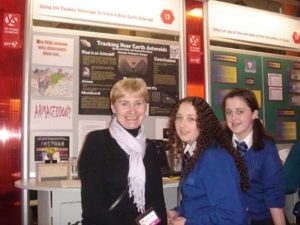
Teacher Jacqui Milligan and her pupils from Glenlola Collegiate School presenting their poster on tracking asteroids with the FTs.
Robert Hill from the Planetarium gave presentations for three days on using the telescope with many schools registering for pupil-research projects with local universities.
The event was officially opened by President Mary MacAleese and saw over 600 school projects being displayed with a total of over 100,000 teachers, school pupils, exhibitors and general public attending throughout the event.
Special mention must go to Glenlola Collegiate School, County Down and teacher Mrs Jacqueline Milligan and her ‘star’ pupils who displayed an excellent project on tracking Near Earth Objects with FT North. There was a lot of interest in their project and the girls from Glenlola did an excellent job of describing their observations and what they learnt. Well done!
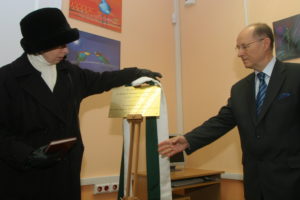
The Princess Royal visiting Czazki High School in Poland
FT North was the focus of a royal visit in Warsaw in 2006, when the Princess Royal was shown the system in operation whilst at Czacki High school who were just about to join the project.
The visit was organised by the British Council Poland, as part of a small-scale pilot of 3 schools and 2 planetaria/observatories across Poland, to join the project.
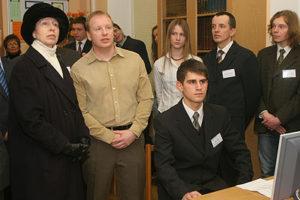
The Princess Royal watching pupils at Czazki High School, using the FTs, whilst Paul Roche explains the process
The Princess Royal spent almost an hour at the school, talking to FT project director Paul Roche and a number of the Polish teachers and students involved in the project. Dr. Lech Mankiewicz, who initially co-ordinated FT use in the country on behalf of BC Poland and the European Hands on Universe project, was able to show the Princess a range of images taken by the Polish schools, and she watched as a number of live observations were taken.
The school continued using the telescopes, producing the posters below for the Warsaw Science Picnic later in 2006, with the help of Physics teacher Barbara Dluzewska .
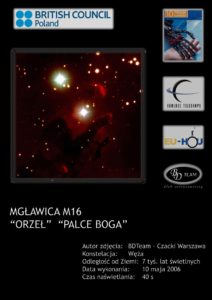
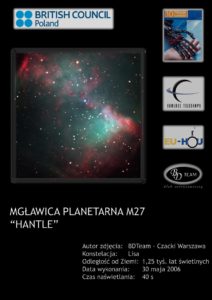
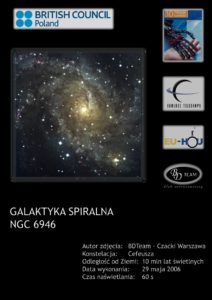
In June 2006, the FTP arrived in Slovakia. A group of students from Niepolomice Youth Astronomical Observatory, accompanied by their teacher, Grzegorz Sek, went to Presov as part of an EU-Hands On Universe workshop. Although they weren’t able to use the telescopes due to problems with the CCD, they managed to download and process images of the planetary nebule NGC 6826, obtained earlier that year at the Warsaw Science Picnic in Poland. Their before and after image can be see here – not a bad afternoon’s work!
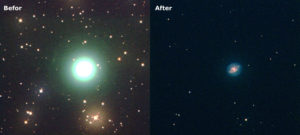
Pupils success at image processing a planetary nebula image taken with FT
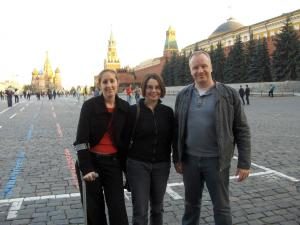
Rachel Dodds, Sarah Roberts and Paul Roche launch FTP in Russia
In September 2006, the FTP was officially launched in Russia! Funded by the British Council in Russia, and co-ordinated by Patrick Fullick of Southampton University, the project involved 24 schools in the 5 regions of Moscow, Ekaterinburg, Samara, St. Petersburg and Nizhny Novgorod. The launch event was held at the prestigious Sternberg Astronomical Institute in Moscow and was attended by British Council officials, academics, students, teachers and astronomers from all 5 regions.
New asteroid!
An aspect of the FTP which was fruitful in 2006 was sending out requests for observations to our users, and having schools take follow up images and data for us. Early in 2006 we asked for users to image asteroid 2004 WB10 (discovered using Faulkes Telescope North in Hawaii). Working with these schools and our German colleagues, Lothar Kurtze and Felix Hormuth (who originally discovered the asteroid in a set of FT images), we received enough observations that were subsequently submitted to the Minor Planet Center that we were able to get the asteroid numbered. Originally called 2004 WB10, a group of schools from the UK were able to rename this asteroid, 3 years later, deciding on the name “Snowdonia”. It’s details can be found here: https://minorplanetcenter.net/db_search/show_object?object_id=129092
Reaching for the stars
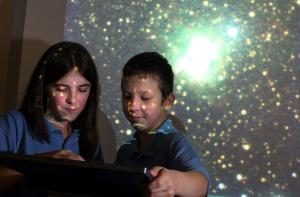 2006 also saw Year 10 pupils from West Monmouth Comprehensive School in Pontypool, South Wales using the Faulkes Telescopes to study GCSE Astronomy. As part of their work they also made a 40 minute presentation of their work to the Basic Skills Agency at the Village Hotel in Cardiff.
2006 also saw Year 10 pupils from West Monmouth Comprehensive School in Pontypool, South Wales using the Faulkes Telescopes to study GCSE Astronomy. As part of their work they also made a 40 minute presentation of their work to the Basic Skills Agency at the Village Hotel in Cardiff.
30 Representatives from the Basic Skills Agency heard how the lower ability students used the telescope not only to learn about astronomy, but also to improve their teamwork and presentation skills. Working together, the class produced a powerpoint presentation of their work which they then took turns to present. This project is an excellent example of the potential contribution that the Faulkes Telescopes can make beyond the Physics curriculum.
A long-term user of the telescopes, Kerry Pendergast said: “The Faulkes Telescope Project has had a major impact on science at West Monmouth School“.
More student success
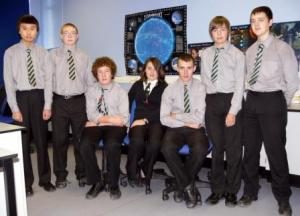 There were more ‘A-star’ performances by students at a school in Lampeter, Wales, who started using the telescopes with sixth form students, but gradually progressed to using it with younger ones as the teacher’s confidence built. “Despite having no expertise in astronomy, members of the science staff decided to ‘have a go’ when we first received information about the telescope. We have subsequently become hooked.” said then Head of Physics, Hillary Lewis.
There were more ‘A-star’ performances by students at a school in Lampeter, Wales, who started using the telescopes with sixth form students, but gradually progressed to using it with younger ones as the teacher’s confidence built. “Despite having no expertise in astronomy, members of the science staff decided to ‘have a go’ when we first received information about the telescope. We have subsequently become hooked.” said then Head of Physics, Hillary Lewis.
“We began observations with sixth form and, gaining confidence, moved on to whole year group presentations with years 9 and 10. As a result of the enthusiasm generated we formed a Year 10 astronomy club which proved particularly popular with the boys. A top activity was looking out for asteroids which might be heading our way!”
“The A level physics students have also benefited having had a realistic taste of research work (including the difficulties of bad weather and natural disasters!). This has developed an interest in some students which has led them to go on to study astrophysics at degree level.”
Let’s hope they’re still gazing up at the stars, 13 years later!
Research
One of the first examples of schools (and a teacher) being cited in a research paper after helping astronomers gather data using the FTs was published in 2006. Mark Wells, a teacher at Oundle School, Northamptonshire was included as an author of a paper published in the prestigious “Monthly Notices of the Royal Astronomical Society” journal. His observations of a binary star system with FT North were included along with data collected by a group led by Matt Burleigh at the University of Leicester.
As well as having Mr Wells listed as an author, the pupils of Oundle School were thanked for their contribution in the acknowledgements of the paper. Section 2.1 of the paper details the contribution made by the school and showed how their observations contributed to the knowledge of the system as a whole.
Posted in News
